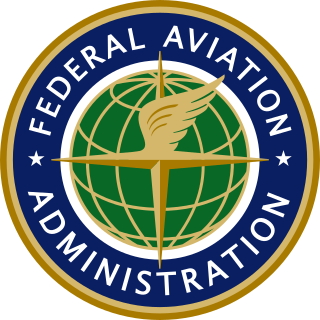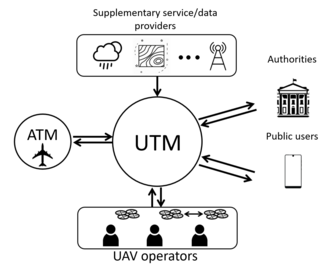
An unmanned aerial vehicle (UAV), or unmanned aircraft system (UAS), commonly known as a drone, is an aircraft with no human pilot, crew, or passengers on board. UAVs were originally developed through the twentieth century for military missions too "dull, dirty or dangerous" for humans, and by the twenty-first, they had become essential assets to most militaries. As control technologies improved and costs fell, their use expanded to many non-military applications. These include aerial photography, area coverage, precision agriculture, forest fire monitoring, river monitoring, environmental monitoring, weather observation, policing and surveillance, infrastructure inspections, smuggling, product deliveries, entertainment, and drone racing.
The Federal Aviation Regulations (FARs) are rules prescribed by the Federal Aviation Administration (FAA) governing all aviation activities in the United States. The FARs comprise Title 14 of the Code of Federal Regulations. A wide variety of activities are regulated, such as aircraft design and maintenance, typical airline flights, pilot training activities, hot-air ballooning, lighter-than-air aircraft, human-made structure heights, obstruction lighting and marking, model rocket launches, commercial space operations, model aircraft operations, unmanned aircraft systems (UAS) and kite flying. The rules are designed to promote safe aviation, protecting pilots, flight attendants, passengers and the general public from unnecessary risk.

Aerial photography is the taking of photographs from an aircraft or other airborne platforms. When taking motion pictures, it is also known as aerial videography.

Pilot certification in the United States is typically required for an individual to act as a pilot-in-command of an aircraft. It is regulated by the Federal Aviation Administration (FAA), a branch of the U.S. Department of Transportation (USDOT). A pilot may be certified under 14 Code of Federal Regulations (CFR) Part 61 or 14 CFR Part 141. Pilots may also be certified under 14 CFR Part 107 for commercial drone operations.

Ultralight aircraft exist outside of the United States. In most countries, ultralights are a class of aircraft. A completely different legal concept is valid within the USA. The FAA makes explicitly clear that ultralight vehicles are not aircraft, are not regulated as aircraft, and are exempt from aircraft rules. Instead, they are treated as powersport items and have to follow their own ruleset, FAR-103, which is the most compact aviation regulation in existence. It can be printed on the front- and backside of a single piece of paper.

First-person view (FPV), also known as remote-person view (RPV), or video piloting, is a method used to control a radio-controlled vehicle from the driver or pilot's viewpoint. Most commonly it is used to pilot a radio-controlled aircraft or other type of unmanned aerial vehicle (UAV) such as a military drone. The operator gets a first-person perspective from an onboard camera that feeds video to FPV goggles or a monitor. More sophisticated setups include a pan-and-tilt gimbaled camera controlled by a gyroscope sensor in the pilot's goggles and with dual onboard cameras, enabling a true stereoscopic view.
The Next Generation Air Transportation System (NextGen) is an ongoing United States Federal Aviation Administration (FAA) project to modernize the National Airspace System (NAS). The FAA began work on NextGen improvements in 2007 and plans to finish the final implementation segment by 2030. The goals of the modernization include using new technologies and procedures to increase the safety, efficiency, capacity, access, flexibility, predictability, and resilience of the NAS while reducing the environmental impact of aviation.
Drone journalism is the use of drones, or unmanned aircraft systems (UAS), for journalistic purposes. According to the Federal Aviation Administration, "an unmanned aircraft is a device that is used, or is intended to be used, for flight in the air with no onboard pilot".

A delivery drone is an unmanned aerial vehicle (UAV) designed to transport items such as packages, medicines, foods, postal mails, and other light goods. Large corporations like Amazon, DHL, and FedEx have started to use drone delivery services. Drones were used effectively in the fight against COVID-19, delivering millions of vaccines and medical supplies across the globe. Drone deliveries are highly efficient, significantly speeding up delivery times and avoiding challenges traditional delivery vehicles may encounter. Given their life-saving potential, use cases for medical supplies in particular have become the most widely tested type of drone delivery, with trials and pilot projects in dozens of countries such as Australia, Canada, Botswana, Ghana, Uganda, the UK, the US among others.

AC 91–57 is an FAA Advisory Circular (AC) that provides interim safety guidance to individuals operating unmanned aircraft, commonly known as drones, but inclusive of flying model aircraft, for recreational purposes in the National Airspace System of the United States.
Unmanned aircraft system simulation focuses on training pilots to control an unmanned aircraft or its payload from a control station. Flight simulation involves a device that artificially re-creates aircraft flight and the environment in which it flies for pilot training, design, or other purposes. It includes replicating the equations that govern how aircraft fly, how they react to applications of flight controls, the effects of other aircraft systems, and how the aircraft reacts to external factors such as air density, turbulence, wind shear, cloud, precipitation, etc.
The US Federal Aviation Administration has adopted the name small unmanned aircraft system (sUAS) to describe aircraft systems without a flight crew on board weighing less than 55 pounds. More common names include UAV, drone, remotely piloted vehicle (RPV), remotely piloted aircraft (RPA), and remotely operated aircraft (ROA). These unmanned aircraft flown in the USA's National Airspace System must operate under the rules of a Community Based Organization for recreational purposes or 14 CFR Part 107 for commercial operations. All UAVs weighing more than 250 grams flown for any purpose must be registered with the FAA.

Regulation of unmanned aerial vehicles (UAVs) involves setting safety requirements, outlining regulations for the safe flying of drones, and enforcing action against errant users.

The Commercial UAS Modernization Act is a bill introduced in the 114th Congress by U.S. Senators Cory Booker (D-NJ) and John Hoeven (R-ND) that would create temporary guidelines for the use of unmanned aircraft systems and regulations for the commercial drone industry. Most commercial use of drones in the U.S. is currently banned by the Federal Aviation Administration (FAA).

An agricultural drone is an unmanned aerial vehicle used in agriculture operations, mostly in yield optimization and in monitoring crop growth and crop production. Agricultural drones provide information on crop growth stages, crop health, and soil variations. Multispectral sensors are used on agricultural drones to image electromagnetic radiation beyond the visible spectrum, including near-infrared and short-wave infrared.
The Drone Federalism Act of 2017 is a bill introduced in the 115th Congress by U.S. Senators Tom Cotton (R-AR), Dianne Feinstein (D-CA), Mike Lee (R-UT), and Richard Blumenthal (D-CT) on May 25, 2017. The bill would "affirm state regulatory authority regarding the operation of unmanned aerial systems (UAS), or drones."

Unmanned aircraft system traffic management (UTM) is an air traffic management ecosystem under development for autonomously controlled operations of unmanned aerial systems (UAS) by the FAA, NASA, other federal partner agencies, and industry. They are collaboratively exploring concepts of operation, data exchange requirements, and a supporting framework to enable multiple UAS operations beyond visual line-of-sight at altitudes under 400 ft above ground level in airspace where FAA air traffic services are not provided.
According to the Civil Aviation Authority of Singapore (CAAS), an unmanned aircraft (UA), commonly known as a drone, is operated without a pilot on board. An unmanned aircraft system (UAS) comprises the UA and associated elements such as the remote control equipment.

RaceDayQuads, LLC v. FAA, also known as Brennan v. Dickson, was a 2022 United States court case heard in the DC Federal Court of Appeals in which the online store RaceDayQuads attempted to challenge the constitutionality and legality of the Federal Aviation Administration's recent remote ID ruling and decision to require that all unmanned aerial vehicles (drones) in US airspace to continuously transmit the location of both the drone and its operator during all operations. The suit, filed by RaceDayQuads owner and CEO Tyler Brennan, was intended to "save the drone industry", including drone racing by using "FPV drones".

Xizmo Media Productions LLC v. City of New York is a pending United States federal court case where the company Xizmo Media Productions argues that the New York City's "Avigation" law, which in effect is a ban on unmanned aerial vehicles within New York City, violates the First Amendment to the United States Constitution. Xizmo argues that New York City's drone ban renders an "inability [for Xizmo] to gather aerial imagery interfering with its directors’ artistic expression". The lawsuit, which is taking place in the United States District Court for the Eastern District of New York, will be decided by federal judge Eric N. Vitaliano.













